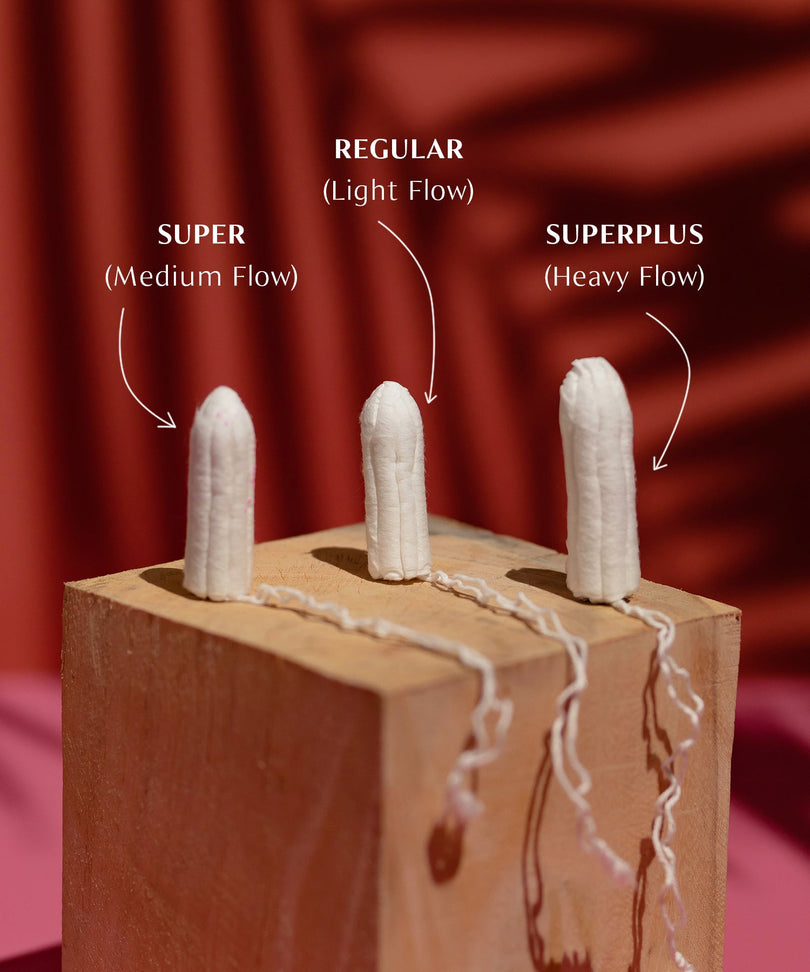The average menstruator bleeds once a month for about 40 years, using about 11,400 pads throughout one’s lifetime. This corresponds to roughly 150 kg of waste. This menstrual waste either ends up in water bodies or landfills.
Since medical products like pads and tampons are not required to disclose their ingredients accurately, you may not be aware of the amounts of chemicals and plastics present in these products.
What are disposable period products made of?
Conventional pads can contain up to 90% plastic including the packaging, top sheet, and base. These plastics are super-absorbent polymers (SAPs) which have the capacity to hold larger volumes of liquid.
Since SAPs are made of sodium polyacrylate, they are not biodegradable and can contribute to harmful side effects including skin allergies, rashes and irritation.
Conventional tampons contain considerably less plastic. A tampon (excluding applicators) can contain upto 6% plastic. It’s usually the string, applicators and packaging of tampons that contain the most plastic.
While tampons may contribute less to plastic pollution than pads, that’s not the only factor used to determine sustainability. Tampons are often flushed which contributes to water pollution, while pads are often thrown in dustbins and sent to landfills. Even certain products which are labelled as recyclable may end up in landfills as some recycling facilities reject items with organic matter (blood) on them.
Also read - Best organic sanitary pad in India
How do plastic period products affect our bodies?
Using sanitary products that contain plastics and other chemicals can cause harm with long-term use.
Since the vagina is highly absorptive of chemicals, the transmission of plastics and chemicals like dioxins, furans and fragrances into the bloodstream can:
- Disrupt the pH levels of the vagina
- Contribute to bacteria buildups when the product is left on for too long
- Increase the risk of developing rashes, menstrual disorders, and even some forms of cancer
Read here to find out more about the risks of chemicals in disposable period products.
How do disposable period products affect the environment?
Since disposable period products are produced in large quantities to meet their demand, the manufacturing process of pads and tampons takes up a significant amount of resources and energy compared to the manufacturing of reusable products.
When period products are disposed of, they either end up in landfills, where they may take upto 800 years to break down. The constituent plastics cannot fully break down and release microplastics into the air and water bodies. Flushed pads and tampons may eventually end up in bodies of water, posing harm to marine life and increasing the concentration of microplastics in water bodies. These microplastics end up being transferred back to us through the food chain, especially in coastal regions.
Disposable period products and their packaging are one of the most commonly found items on beach shores and in the ocean.
Also read - Best way to dispose of sanitary pads
How is menstrual waste managed?
There are multiple ways through which menstrual waste is managed depending on whether it has been thrown or flushed.
In developing countries like India, waste pickers manually segregate waste, putting their own health at risk as they come in contact with harmful bacteria when sorting out waste. Pads/tampons can be soaked with infected blood which retains its infectivity and can lead to the transfer of diseases like HIV or hepatitis.
Alternatively, menstrual waste is sometimes burned in incinerators, which releases harmful pollutants into the air.
When pads/tampons are flushed, they may clog sewage lines as their chemicals like polyacrylate are highly absorbent and absorb the water coming through the sewage lines which can result in sewage backflow.
While a better-coordinated approach in terms of sanitary waste collection and disposal could curb this impact, it’s up to us as consumers to find alternatives which reduce the load on waste management systems.
Also read - Find perfect sanitary pad for you
Which period products are eco-friendly options?
There is a large variety of sustainable period products that cater to every preference and this product market is only expanding! Make sure to research and read the labels on the products before you buy them, as some products may still contain amounts of plastics despite being labelled otherwise.
You can use:
- Organic Pads
- Organic Tampons
- Menstrual Cup
- Period Underwear
- Reusable Cloth Pads
Read more
Sustainable alternative of sanitary pads









